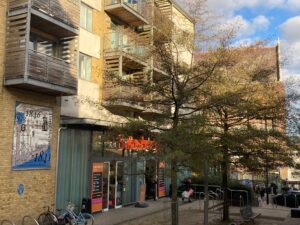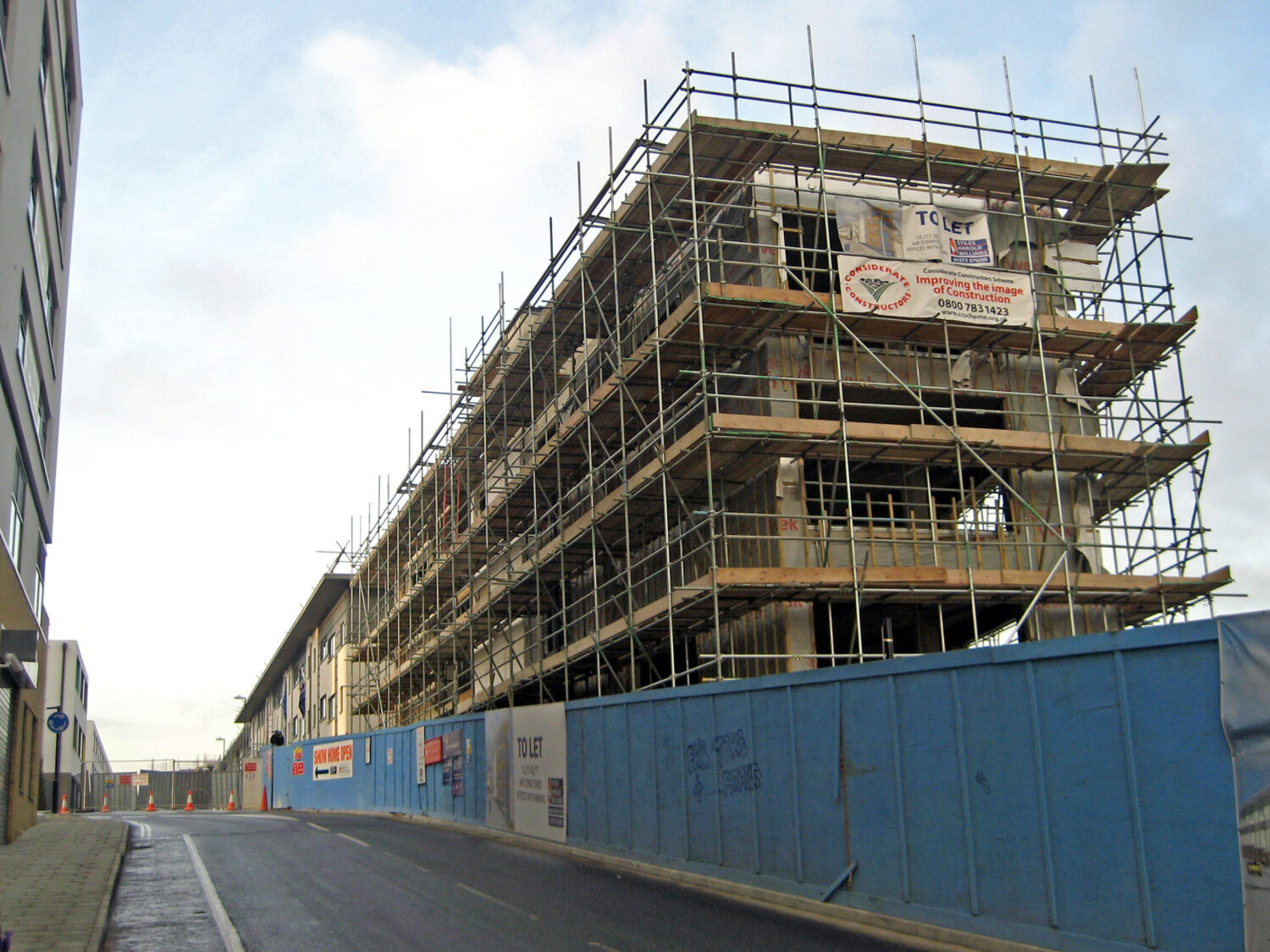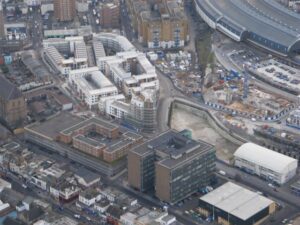Building Better
When it comes to building more homes, we already know what kind of development works, writes Nicholas Falk
The next government will be tasked with building many more homes – and better ones – with limited public funds. This is, clearly, a significant fiscal and political challenge. However, when it comes to what we build, there is little mystery as to what works – nor has there been for the best part of 20 years. Places with character and plenty of greenery, a diversity of tenures and uses, and without a reliance on cars are desirable and achievable for both urban and suburban sites.
You can see a good example as you pull into Brighton station. The New England Quarter, named after an adjoining street, was built on the site of a former railway goods yard and locomotive works next to the Grade I-listed Victorian railway terminus. This 15-acre, steeply sloping site was owned by Network Rail, and lay vacant for over 30 years as a makeshift car park. The redeveloped site now provides 261 residential homes, a language school with accommodation for 400 students, two hotels linked to the station, live-work accommodation and various other community assets such as a green corridor.
To address our housing crisis, it will be vital to mobilise public land, especially around railway and bus stations where environmental and social benefit can be secured. This case study shows how a creative and proactive approach to housing development can unlock highly constrained sites owned by public utilities to promote urban regeneration. It also confirms the need for radical changes to speed up the development process on similar strategic sites, and secure community benefits.

The New England Quarter
The road to our eventual success was not an easy one. The application was vigorously opposed by a local campaigning group called BUDD (Brighton Urban Design and Development), who wanted the whole site used for social housing. Unusually, URBED was asked by both the group and Sainsbury’s, whose development arm was funding the project, to consider alternatives.
URBED’s masterplan incorporated a large Sainsbury’s supermarket with housing above, a combination which funded a new road to open up the site. The eventual total investment in the site was £250m – with no public grant.
Many of the elements were innovative at the time. There is a mix of uses and tenure, and the development was one of the first schemes to place housing over a supermarket. Parking for residents was kept to a minimum, and the site is heavily pedestrianised, with a green corridor. The plan divided the site into a number of blocks to be implemented by different developers. Two of the main blocks, known as One Brighton, were developed by the environmental group BioRegional with St Quintain and Crest Nicholson, with 172 flats designed to be carbon neutral. London Road, the area’s main shopping street, was improved without any loss of trade: the development provides a direct route from the station to London Road, with a public square. The public realm is animated by having lots of students at the language school.
Sustainable Urban Neighbourhoods
The completed scheme has won many awards and offers a model for higher density mixed use schemes in areas around major transport hubs. It forms a major case study in my book, written jointly with David Rudlin, on building the 21st century home. However, it took 16 years to build the New England Quarter in its entirety, with conflicts which no house builder would knowingly take on. The community group continued to oppose the scheme until it had been completed, when it won general support. These issues are particularly pertinent today: local authorities no longer have staff with the capacity to see through such a project from vision to results. Nor are retailers looking to invest as Sainsbury’s once did. So Labour needs a housing policy that will break down the barriers to building better, and mobilise institutional finance.
The process would have been better and faster if:
- the site had been identified earlier for intensification,
- the local authority had the capacity to prepare a proper development brief,
- the wider community had been consulted at the start on priorities and development principles,
- a partnership to take over adjoining property had been set up,
- a financial institution has funded local infrastructure through a bond secured against the site,
- and a development trust had taken over and managed the green space.
There are hundreds of plots of underused land near to railway and bus stations all over England, often former goods yards and coal depots, which were once attached to every station. They are usually held in complex ownership and generate little income for either the owners or the local authority. This applies especially to mid-sized towns that have lost shops and leisure facilities, and where councils generally lack development expertise and finance due to cutbacks. They include historic towns like Oxford, Gloucester and York, as well as the many industrial and coastal towns that have suffered from economic decline.
Elsewhere, new garden cities, applying an updated version of the postwar new town development corporations, could boost economic growth as well as widen housing choice, as the success of Warrington and Milton Keynes, in particular, illustrate.
So what could a new government do in its first term? Here are four priorities:
- Land assembly: The government should make the most of publicly owned and underused land. Sites can be readily identified from maps and aerial photographs, supplemented through GIS (Geographic Information Systems) to pick the best prospects. Proposals for simplifying the compulsory purchase process should reform the compensation code so that ‘hope value’ is discounted. As some incentive is needed, a practical compromise would be to follow the Dutch example and enable the original owners to receive 25 per cent of the eventual value after a site has been developed, or the existing use value if they are unwilling to wait.
- Planning capacity: As it takes time to align competing interests, national government and combined authorities need to be given the lead role in strategic planning. The government should also enable bodies with development corporation powers to be set up, with a remit to make the most of underused land. Local expertise needs to be tapped, for example by encouraging local colleges to train people in urbanism and sustainable development. Funding is needed to rebuild local teams, not just employ consultants.
- Housing design: Lessons should be drawn from previous government attempts to build ‘ecotowns’, Millennium Communities, and garden cities, where delivery has been painfully slow, and the quality often disappointing. Comparisons should be made with the experience in continental cities that have solved the problem by empowering local authorities to build homes that are both affordable and sustainable; the Dutch VINEX programme, for example, used 95 urban extensions to increase the housing stock by 7.6 per cent in 10 years. There are a host of studies to draw on, and URBED’s report on Uxcester Garden City, which won the 2014 Wolfson Economic Prize, showed how to double the size of a city like Oxford without subsidy and at the cost of only 5 per cent of the surrounding green belt.
- Community engagement: Finally, resistance to change can be reduced by first discovering what concerns people most, and then setting up trusts to promote and maintain natural parks and other community uses. The transformation of Kings Cross Railway Lands shows the possibilities. Community Land Trusts could cater for markets that are missed by house builders and social housing. Competitions should aim to identify opportunities and fund the feasibility studies and preparation work needed. A hundred ‘green beacons’ in mid-sized towns would revive hope of a better future for all. Indeed, a focus on quality and not just housing numbers would not only improve public health but also be a very effective way of raising productivity and achieving Labour’s growth objectives.
Image credit (pinned News & Insight): Hassocks5489, CC0 via Wikimedia Commons
Image credit (main): Mark Wordy via Flickr
All other photos supplied by author.


